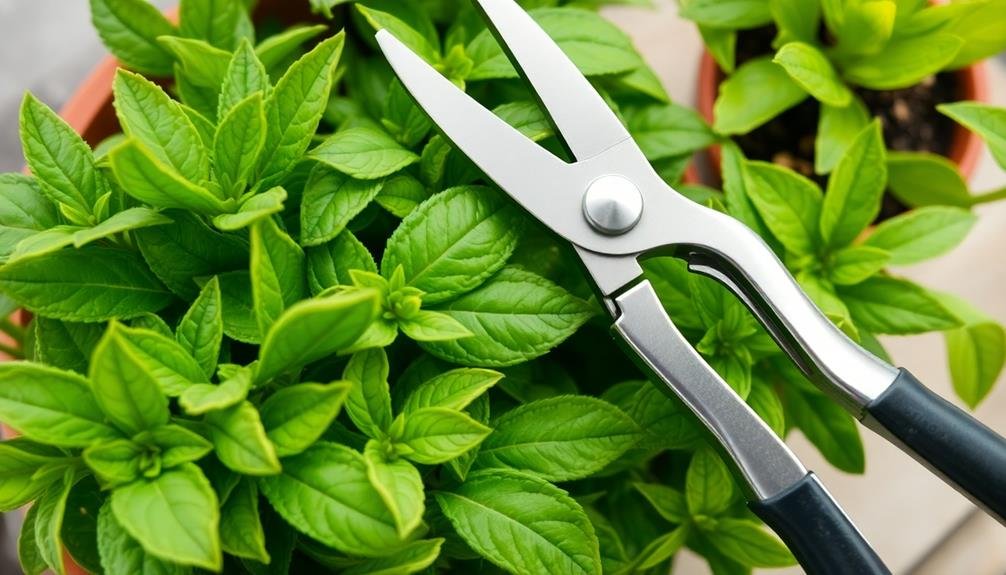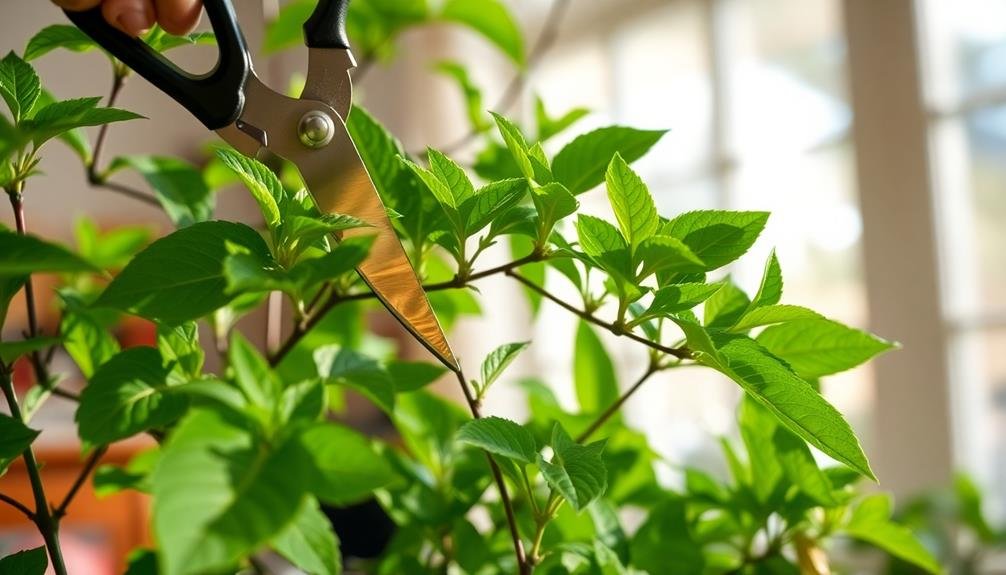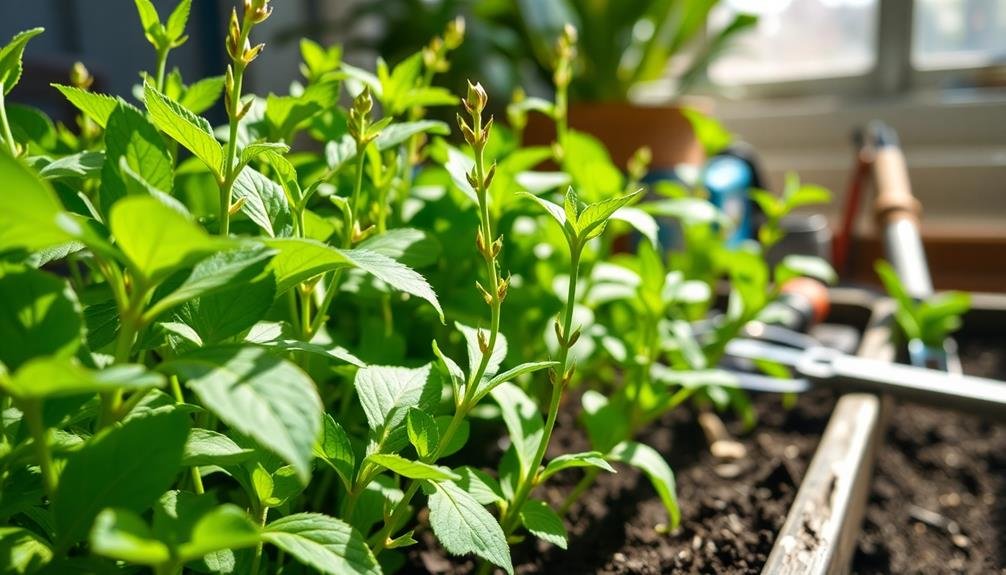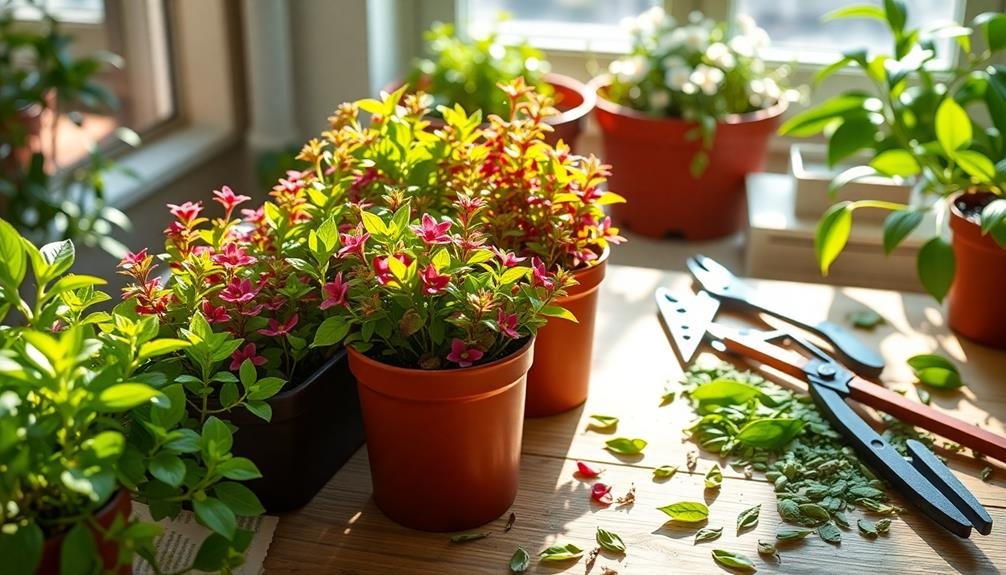To successfully prune your indoor tea herbs, start with quality tools like sharp pruning shears. Understand their growth stages to choose the right moment to prune. Always cut cleanly above a leaf node to encourage new growth, and trim for size and shape while maintaining good air circulation. Be mindful of seasonal timing—spring and late summer are ideal. Monitor plant health post-pruning, looking for signs of recovery and new growth. These techniques will guarantee your herbs thrive and produce abundantly. Want to refine your skills even further? There's much more to explore about effective pruning techniques.
Choose the Right Tools

When it comes to pruning your indoor tea herbs, having the right tools makes all the difference. You'll want to invest in high-quality pruning shears or scissors. Sharp blades cut cleanly, minimizing damage to your plants and promoting quicker healing.
Look for tools that fit comfortably in your hand, as you'll be using them frequently. Consider a pair of curved shears for precision cuts, especially around delicate stems. If you're dealing with thicker branches, a bypass pruner can save you effort and time.
Don't forget about gloves; they protect your hands from sap and sharp edges while giving you a better grip. A small trowel can also be handy for removing any dead leaves or debris from the soil, ensuring your herbs stay healthy.
As you prune, keep a spray bottle filled with water nearby to mist the cut areas. This helps keep the plant hydrated and reduces stress.
Understand Plant Growth Stages
Understanding the various growth stages of your indoor tea herbs is essential for effective pruning. Your herbs typically go through four main stages: germination, vegetative, flowering, and dormancy.
During the germination stage, seeds sprout and begin to grow roots and leaves. It's a delicate time, so handle your young plants carefully.
Once they're established, they enter the vegetative stage, where growth accelerates. This is when you'll want to start shaping your herbs through light pruning to promote bushier growth and prevent overcrowding.
As your plants progress to the flowering stage, they focus their energy on blooming. This is a critical time; while you may be tempted to prune heavily, it's best to only remove dead leaves or spent blooms to avoid stressing the plant.
Identify When to Prune

Knowing when to prune your indoor tea herbs is key to their health and growth.
Watch for signs like leggy stems or yellowing leaves, which indicate it's time for a trim.
Additionally, understanding seasonal timing and the specific growth stages of your herbs can help you make the most of your pruning efforts.
Signs Your Herbs Need Pruning
Observing your indoor tea herbs closely can reveal vital signs that they need pruning. One of the first indicators is leggy growth, where stems stretch toward the light, leaving them weak and sparse. If you notice this, it's time to trim back those elongated stems to encourage bushier growth.
Another sign to watch for is yellowing leaves. This can indicate overwatering or nutrient deficiencies, but if it's paired with rapid growth, pruning can help redirect energy to healthier parts of the plant.
Additionally, if you spot any dead or damaged leaves, it's important to remove them. Not only does this improve appearance, but it also prevents pests and diseases from spreading.
You might also notice overcrowding in your pots. When herbs compete for space and nutrients, they can become stunted. Pruning back some of the foliage allows for better airflow and light penetration, promoting overall health.
Seasonal Pruning Timing Tips
Pruning your indoor tea herbs at the right time can make a significant difference in their growth and health. Timing is key to ensuring your plants thrive. Generally, the best times to prune are during the early spring and late summer, as this aligns with their natural growth cycles.
Here's a quick reference table to help you decide when to prune:
| Season | Best Time to Prune | Reason |
|---|---|---|
| Spring | March – April | Encourages new growth |
| Summer | July – August | Controls size and shape |
| Fall | September – October | Prepares for dormancy |
| Winter | Minimal Pruning | Reduces stress on the plant |
| Anytime | Remove dead leaves | Improves air circulation |
Growth Stages for Pruning
Understanding the growth stages of your indoor tea herbs is essential for effective pruning. Each stage offers unique opportunities to shape your plants for best growth and yield.
Start by observing the early growth stage, which usually occurs in spring. At this point, your herbs are just beginning to sprout new leaves and shoots. Pruning during this stage encourages bushier growth and helps establish a strong foundation. Aim to remove any weak or leggy stems to promote healthy branching.
As your herbs enter the active growth stage, typically in mid-spring to summer, you'll want to focus on maintaining shape. Regularly trim back any overgrown or unruly branches. This not only keeps your plants looking neat but also maximizes light exposure, leading to better leaf production.
Once your plants reach maturity, you can perform a more substantial pruning to rejuvenate them. This is especially important for perennial herbs that can become woody over time.
Just remember to prune selectively, targeting older stems while leaving enough healthy growth to promote continuous production.
Use Clean Cutting Techniques
When it comes to maintaining the health of your indoor tea herbs, using clean cutting techniques is essential. By guaranteeing that your tools are sharp and sanitized, you minimize the risk of introducing diseases or pests that can harm your plants.
Start by using clean, sharp scissors or pruning shears. Dull blades can crush stems, making the plants more susceptible to infections.
Before you begin, disinfect your cutting tools with rubbing alcohol or a bleach solution. This simple step can prevent the spread of pathogens from one plant to another.
When cutting, aim for a clean, angled cut just above a leaf node. This promotes healthy regrowth and guarantees that moisture doesn't accumulate on the cut surface, which can lead to rot.
Always cut only what's necessary. Avoid excessive pruning, as it can shock the plant and stunt its growth. Instead, focus on removing dead or yellowing leaves and any stems that appear weak or unhealthy.
Trim for Shape and Size

To keep your indoor tea herbs healthy and attractive, it's crucial to trim them for shape and size.
Start by understanding their growth patterns, so you know where to cut for ideal results.
Using the right tools and timing your pruning will make a big difference in how your herbs thrive.
Understand Growth Patterns
Many indoor tea herbs exhibit unique growth patterns that can influence how you trim them for ideal shape and size. Understanding these patterns will aid you in maintaining a balanced, healthy plant. For instance, some herbs, like mint, grow vigorously and can become leggy if not pruned regularly. In contrast, herbs like chamomile tend to have a more compact growth habit.
By recognizing these patterns, you can decide when and how much to trim. Here's a quick reference table to help you understand common growth patterns in indoor tea herbs:
| Herb Type | Growth Pattern |
|---|---|
| Mint | Vigorous and sprawling |
| Chamomile | Compact and bushy |
| Lemon Balm | Upright with occasional leggy |
| Thyme | Low-growing and spreading |
| Oregano | Dense with upright stems |
Trimming according to these patterns not only helps shape the plant but also encourages healthier growth. Keep an eye on your herbs, and don't hesitate to prune them when they start straying from their intended form. This proactive approach will guarantee your indoor tea herbs thrive beautifully.
Use Proper Tools
Using the right tools is essential for effective pruning, as they can greatly impact your indoor tea herbs' shape and size. Sharp, clean pruning shears or scissors are your best friends here. They guarantee precise cuts, which help minimize damage to the plant. Dull tools can crush stems and lead to infections, so make certain to sharpen them regularly.
When trimming for shape, focus on removing any dead or yellowing leaves first. This not only tidies up your plants but also directs energy to healthier growth.
Next, look for any overly long or leggy stems. Use your pruning shears to trim them back, encouraging denser growth and a bushier appearance.
For size management, it's important to cut back any branches that are getting too tall or wide. This keeps your plants from becoming unruly and guarantees they fit nicely in their designated space. Remember to cut just above a leaf node to promote new growth in the right direction.
After you've finished pruning, clean your tools with rubbing alcohol to prevent disease transmission between plants. Taking these steps will help your indoor tea herbs thrive beautifully.
Timing Your Pruning
Pruning your indoor tea herbs at the right time is essential for maintaining their health and shape. Timing is key to ensuring your plants thrive and produce flavorful leaves. Generally, you should prune during the growing season, which is spring and early summer. This allows your herbs to recover quickly and encourages new growth.
Here are some tips to help you determine when to prune:
- Monitor Growth: If your herbs are becoming leggy or overgrown, it's time to trim them back for better shape.
- Check Leaf Health: Yellowing or browning leaves can indicate the need for pruning to encourage healthier growth.
- Promote Airflow: Pruning during warmer months helps improve airflow, reducing the risk of mold and pests.
- Harvest Regularly: Regularly snipping off leaves not only helps keep your herbs in shape but also encourages new growth, ensuring a continuous supply of fresh leaves.
Remove Dead or Diseased Leaves
To maintain the health of your indoor tea herbs, regularly check for dead or diseased leaves. These leaves can harbor pests and diseases that may spread to healthy parts of your plants. By removing them promptly, you help guarantee your herbs remain robust and productive.
When inspecting your plants, look for discolored, wilting, or brittle leaves. If you find any that seem unhealthy, don't hesitate to trim them off. Use clean, sharp scissors or pruning shears to make precise cuts, minimizing stress on the plant.
Here's a handy table to help you identify common issues:
| Condition | Signs | Action |
|---|---|---|
| Wilting | Droopy leaves | Water the plant |
| Yellowing | Discoloration | Remove affected leaves |
| Brown spots | Fungal infection | Trim and treat soil |
Encourage New Growth

To encourage new growth in your indoor tea herbs, timing is essential for effective pruning.
You'll want to use proper cutting techniques to guarantee your plants thrive, while also promoting lateral growth for a fuller appearance.
Let's explore how to achieve these goals for a healthier herb garden.
Timing for Pruning
During the growing season, timing your pruning can greatly encourage new growth in your indoor tea herbs. Typically, the best time to prune is in the spring when your plants are waking up from dormancy. This is when they'll be most responsive to the cuts you make, leading to lush, new foliage.
Aim to prune just after the last frost, allowing your herbs to rejuvenate and thrive as temperatures rise.
Keep in mind these key points for ideal pruning timing:
- Observe growth patterns: Watch for signs of new growth, which indicates your herbs are ready for pruning.
- Consider the light: Confirm your plants have access to ample light during the growing season to support recovery.
- Avoid stress periods: Don't prune during heat waves or drought, as this can shock your plants.
- Regular maintenance: Prune regularly throughout the growing season to promote continuous growth and prevent overgrowth.
Proper Cutting Techniques
Understanding the right cutting techniques can greatly enhance the new growth of your indoor tea herbs. When you prune, always use sharp, clean scissors or pruning shears. This helps prevent damage and reduces the risk of disease. Aim to cut just above a leaf node—this is where new growth will emerge. By making the cut at an angle, you encourage water to run off, minimizing the chance of rot.
It's best to remove any dead or yellowing leaves first. This not only improves the plant's appearance but also allows energy to be redirected toward healthier parts.
If you're working with stems, aim to cut back about one-third of the plant's height. This stimulates growth without shocking the plant.
Another key technique is to prune during the growing season, typically in spring or early summer. This timing guarantees that your herbs have the energy to recover and thrive.
Promote Lateral Growth
Encouraging lateral growth in your indoor tea herbs is vital for a bushier, more productive plant. When you prune correctly, you stimulate the growth of side shoots, leading to a fuller and healthier herb.
Here are some tips to help you promote lateral growth effectively:
- Cut Above the Node: When pruning, always cut just above a leaf node. This encourages new growth to sprout from that point.
- Pinch the Tips: Gently pinch off the growing tips of your herbs. This simple action redirects energy to the lower branches, fostering lateral growth.
- Regularly Rotate Your Plants: Turning your pots helps guarantee all sides receive equal light, which promotes balanced growth throughout the plant.
- Fertilize Wisely: Use a balanced fertilizer during the growing season. This gives your herbs the nutrients they need to thrive and encourages side shoots.
Prune for Air Circulation
Proper air circulation is essential for your indoor tea herbs to thrive. Without it, your plants can suffer from mold, pests, and diseases, which can hinder their growth and health.
To promote good airflow, start by examining the structure of your herbs. If you notice overcrowding or areas where leaves are densely packed, it's time to prune.
Focus on removing any dead or yellowing leaves first, as they can obstruct airflow and serve as breeding grounds for pests. Next, identify stems that cross each other or grow inward. Cut these back to create space, allowing air to flow freely around the remaining foliage. When you trim, make clean cuts to avoid damaging the plant.
Additionally, aim to maintain an open center in your herbs. This not only improves air circulation but also encourages better light penetration, helping your plants photosynthesize effectively.
Timing Your Pruning Sessions

Timing is essential when it comes to pruning your indoor tea herbs for ideal growth and health. You want to prune during specific times to encourage robust growth and maintain your plants' health. Generally, the best time to prune is during the growing season, which typically spans from spring through early summer. This is when your herbs are most active and can heal quickly from cuts.
Here are some key times to reflect on:
- After flowering: Pruning right after your herbs bloom can help redirect energy back into leaf growth.
- When growth slows: If you notice your herbs aren't growing as vigorously, a light trim can stimulate new growth.
- Before repotting: Pruning before moving your herbs to a larger pot can help reduce shock and encourage new growth in the fresh soil.
- Regular maintenance: Aim for minor trims every few weeks to keep your herbs bushy and healthy.
Monitor After Pruning
After pruning your indoor tea herbs, it's important to keep an eye on their recovery process. Monitoring their growth will help you understand how well they respond to pruning and guarantee they thrive in their environment. Look for signs of new growth and assess the overall health of your plants regularly.
Here's a quick guide to help you track your herbs' recovery:
| Observation | What to Look For | Action to Take |
|---|---|---|
| New Growth | Fresh leaves and stems | Continue regular care routine |
| Wilting Leaves | Droopy or discolored leaves | Check watering and humidity levels |
| Pests | Insects or webbing on leaves | Treat with insecticidal soap |
| Stunted Growth | No new growth after a few weeks | Re-evaluate light and nutrients |
Frequently Asked Questions
Can I Prune My Tea Herbs During Winter?
Yes, you can prune your tea herbs during winter. Just make sure to avoid cutting too much, as plants need energy to survive the cold. Light pruning encourages growth when spring arrives, keeping your herbs healthy.
How Often Should I Prune Indoor Tea Herbs?
You should prune your indoor tea herbs every few weeks during the growing season. Regularly removing dead leaves and stems encourages healthy growth and guarantees your plants remain vibrant and productive throughout their growth cycle.
What Should I Do With Pruned Stems?
After pruning, you can use the stems for propagation, placing them in water until roots form. Alternatively, compost them to enrich your soil, or dry them for herbal teas. Don't waste those valuable resources!
Are There Specific Times to Avoid Pruning?
You should avoid pruning during extreme weather conditions, like frost or heat waves. Also, steer clear of pruning during the plant's active growth phase, as it needs energy to thrive and recover from cuts.
Can Over-Pruning Harm My Tea Herbs?
Yes, over-pruning can harm your tea herbs. It weakens their growth and may lead to stress or stunted development. Always prune selectively and keep an eye on your plants' health to guarantee they thrive.
In Summary
By following these essential pruning tips for your indoor tea herbs, you'll keep your plants healthy and thriving. Remember to choose the right tools, understand their growth stages, and prune at the right times. Clean cuts, shaping, and encouraging new growth are key to enhancing air circulation and overall plant health. Keep an eye on your herbs after pruning to guarantee they flourish. With a little care, you'll enjoy a bountiful supply of fresh tea right at home!





Leave a Reply